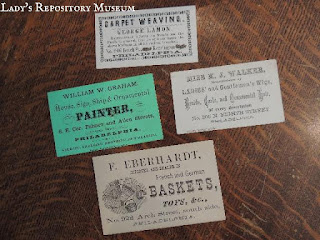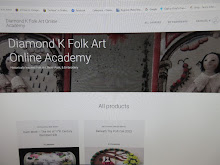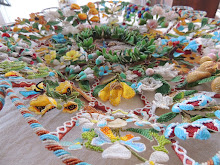c1790-1820 Knit Basket Purse 932.2016.55
This week's Museum Monday lucky number is 932! I couldn't be more thrilled, as this is one of my favorite pieces~ I know I always say that, but this one may just be a little more special than most of my really specials. I have always admired anything knit with beads, beaded purses...beaded baby caps and jackets....Native American beadwork....and of all, the most elusive are the purses of this type you see above. These are early, late 18th century to the second decade 19th, and knit with weensie knitting beads~ but what sets these purses aside from all the others, is their shape. Early knit basket purses are supported by wooden hoops.
I have spent nearly 30 years pining for a basket purse, and finally found one, tho as you see in the photo above it was not happy and cheerful like it once was....but not to worry, a little love and care is all it needed~
Its shape was tired after so many years~ first to attend to was to make a new bottom plate. Measures were carefully taken of the bottom diameter, and I cut a new plate from heavy archival card. Luckily the original plate was still in the bottom of the purse, so I took it out and used it for a color match of the same thin tissue silk taffeta covering.
To the left you can see the original bottom plate, which is layers of card/paper with a silk covering. The cards had gotten damp and are now all balled up inside the covering. The once original shape is a drastic change to what it is now, which in this type of purse, greatly effects the silhouette.
Before inserting, I again check the measure to be sure it will fit like a glove once inside. I used three layers of heavy card, they are quite stiff, but still flexible enough to roll up to insert thru the one & a quarter inch wide neck above the bottom section of the purse
New bottom plate inserted~ the original is of coarse kept in stores with the purse always.
Next was to make a new hoop for the center section. Some purses have the hoop(s) stitched in place, but most do not, as this detracts from the outside design. It is easy to understand why many have lost their original wooden hoops~ they are much easier to store with hoops removed. Of coarse some have hoops inserted as they were knit, and those are really fabulous!!
I made a hoop from a scrap of some wooden basket making reeds~ something that would be readily available in the years these purses were made and most likely found in the house.
A 16" piece was cut and bound together at the ends with wooden pegs. All was sanded smooth.
The top when fully opened easily accommodated the hoop and here you can see it as it rests gently in place inside the widest part of the purse. Also note the very narrow neck of the bottom section~
Weensie knitting beads in rare yellow color~ aside from reds, yellows were the next highest cost of beads due to the minerals needed to make the color
Pretty pansies, with leaves done in transparent, opaque and 'greasy' beads
Original tasseled drawstring ties at the very top above a row of bead work leaves
Now, a happy purse with correct silhouette.
I hope you enjoyed this Museum Monday~ if you would like to pick a number between 1-945 Ill add it to the hat to pick from for next weeks post~ you can email me or leave in the comments section below.




























































